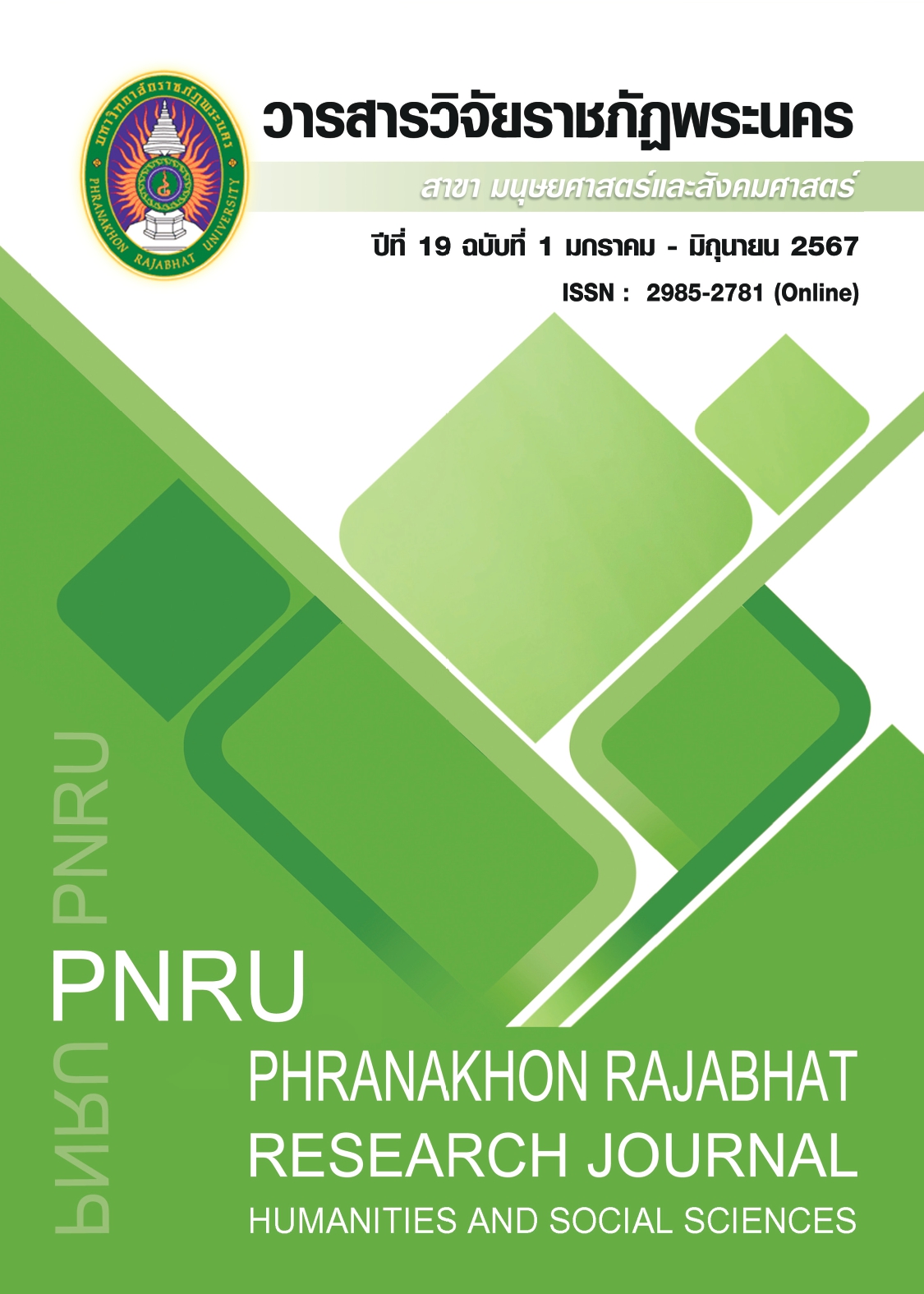TEACHING GUIDELINES TO PROMOTE THE USE OF ENGLISH FOR COMMUNICATION OF UNIVERSITIES IN PATHUM THANI PROVINCE
Main Article Content
Abstract
The objectives of this research were 1. to study the problems of using English for communication in the classroom. 2. to study satisfaction with learning English for communication in the classroom. 3. to propose teaching methods to promote the use of English for communication in the classroom. This research was a mixed method research. Qualitative research collected data through interviews and open-ended questionnaires to study problems in the use of English for communication in the classroom and to propose teaching methods to promote the use of English for communication in the classroom. In addition, the researcher used quantitative research to collect data by using questionnaires to study satisfaction with learning English for communication in the classroom by collecting from students at universities in Pathum Thani Province total 400 people.
The results of the study showed that regarding to the problems in using English for classroom communication. It was found that there were too many students in the classroom, anxiety in using language to communicate with their classmates, time preparation for communication and selecting appropriate topics. 2. The level of opinions of students regarding their satisfaction in learning English for communication in the classroom, it was at a high level. Considering each aspect, teacher was at the highest average followed by learning content, teaching media, classroom activities and teaching and learning evaluation respectively 3. According to the guidelines, it was found that there were 5 guidelines proposed in terms of teaching and learning to promote the use of English for communication, namely: 1. designing classroom size with appropriateness, organizing time preparation for students, creating activities outside the classroom to promote and support students’ learning from the environment to create motivation. Lastly, speaking teachers should be a good role model in the use of language.
Article Details

This work is licensed under a Creative Commons Attribution-NonCommercial-NoDerivatives 4.0 International License.
Each publish articles were copyright by Phranakorn Rajabhat University
Any contents which appeared in each articles in the journal were authors personal opinion. It did not relate to Phranakorn Rajabhat University and other instructors in the university. Each authors would take responsibility on their articles. If there are any mistake, the authors will take responsibility themselves
References
Brown, J. D. (1993). Self-Esteem and Self-Evaluations: Feeling is Believing. Psychological Perspectives on the Self. Open Journal of Social Sciences, 7(2), 47-58.
Little, W. (1983). Communicative Language Teaching: An Introduction. Cambridge: Cambridge University Press.
Widdowson, H.G. (1979). Explorations in Applied Linguistics. (2 Vols). Oxford:
Oxford University press.
Dornyei, Z. (2001). Communicative Language Teaching in the twenty-first century: the Principled Communicative Approach. Cambridge England: Cambridge University press.
Thonhpanchang, C. (2017). Development of activity sets to practice English skills for communication in careers. (Master of Education in English Curriculum and Teaching) Uttaradit Rajabhat University, Uttaradit. (In Thai)
Kaewthongma, N. (2017). Creating a set of activities to develop English skills for communication on the topic My life using the theory of creating self-knowledge by creating work pieces for Mathayomsuksa 2 at Uttaradit School. (Master of Education in English Curriculum and Teaching), Uttaradit Rajabhat University, Uttaradit. (In Thai)
Chaemchai, W. (2016). Effects of practice-based teaching on English writing skills of primary school students. Mathayom 3. (Master of Arts) Buriram Rajabhat University, Buriram. (In Thai)
Chamroennusit, S. (2015). Golden opportunity for learning window of opportunity. Journal of Education Burapha University 31(3), 120-138. (In Thai)
Padlian, B. & Jongkonklang, S. (2020). A study of academic achievement in English and Reading comprehension ability of Mathayom 1 students using SQ4R learning management together with multipart strategies. Journal of Education Burapha University. 31(3), 99-108. (In Thai)
Iambunyarit, P., Phuripanik, C. & Rakbamrung, T. (2020). Teaching analytical reading through the Active Learning process to develop analytical thinking skills of Thai children in the Gen Z era. Journal of Education Burapha University. 31(3), 1-11. (In Thai)
Phewphan, A. (2017). Results of organizing experiences according to natural language
teaching methods that affect language development regarding listening skills and speaking skills of early childhood children who use Thai as a second language. (Master of Education in Curriculum and Teaching). Chiang Rai Rajabhat University, Chiang Rai. (In Thai)
Office of the Basic Education Commission. (2015). Teaching and learning management Manual for a new style of English according to the framework of international English proficiency standards. Retrieved fromhttps://rnedu.go.th/2019/wp-content/uploads/2015/10/book-policy-obec-61.pdf [2022, 15 July.] (In Thai)
Richard, C. J. (2022). Initiating professional development in language teaching. University of Sydney Journal of TESOL, 3(1), 485-497.
Praimahaniyom, T., Kamutthapichai, C. & Panklam, A. (2023) Enhancing English Reading for Critical Thinking with Aesop’s Fables for EFL Learners. Journal of Innovation in Educational Management and Research, 5(3), 124-138. (In Thai)
Ritthirat, N. (2012). Thai University Students’ English Oral Proficiency and Problems to Developing English Speaking Skill. (Master of Arts in Teaching English as an International Language). Prince of Songkla University, Songkla. (In Thai)
SUWANTARATHIP, O. (2019). Predictors of Students' Satisfaction with a Hybrid English Course. Turkish Online Journal of Distance Education 20(1), 115-130.
Jedo, K. (2017). Satisfaction of YRU Students towards Teaching English based on Communicative Language Teaching Approach. (Report No. 34). Yala, Thailand: Yala Rajabhat University. (In Thai)
Ubon Ratchathani University. (2017). Plan for developing students' English language skills Ubon Ratchathani University 2017 – 2021. Retrieved https://www.ubu.ac.th/web/files_up/00046f2020122911401330.pdf [2022, 15 July.] (In Thai)


